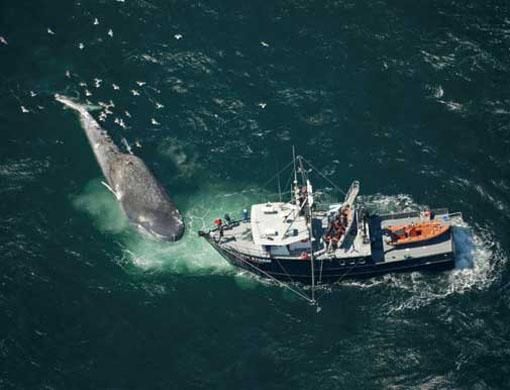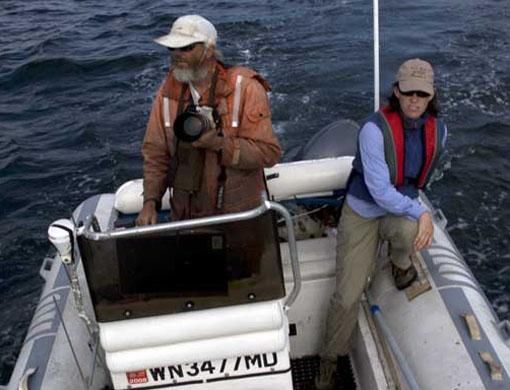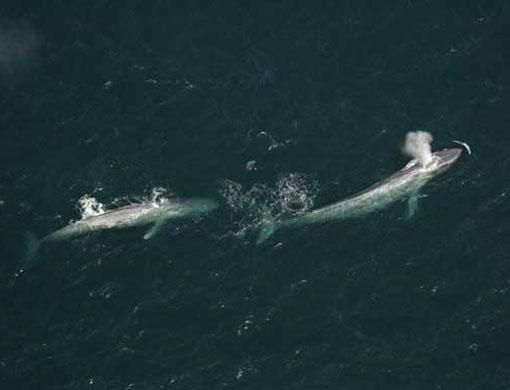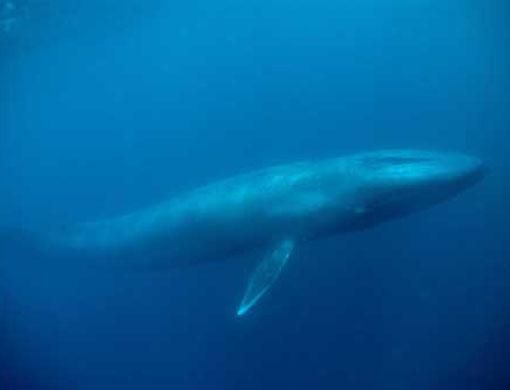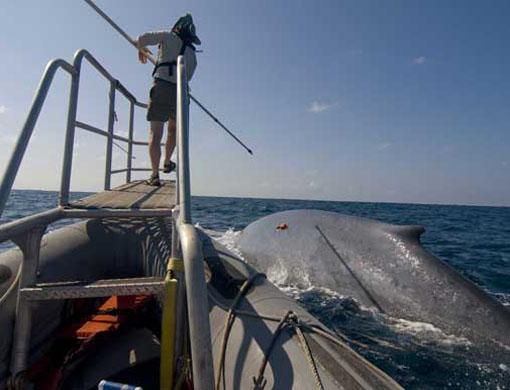They are the largest creatures to ever live on our planet — larger than any of the great dinosaurs — yet few people have seen one.
They are one of the loudest animals on land or sea — but we struggle to hear them. They deliver the world's largest babies but most of the places where blue whales calve their young remain a mystery.
National Geographic Channel takes viewers into the Big Blue — a film featuring the first underwater footage of a blue whale calf.
Dwindling numbers
In many places, blue whales are so rare that experts know very little about them but in most places we know their future is threatened.
The population of blue whales in the Eastern North Pacific once numbered close to 10,000 animals but more than a century of whaling took its toll.
Although hunting blue whales has been banned since the 1960s, today, fewer than 2,000 blues are left in the Antarctic.
In an effort to learn more about these behemoths and to help protect them, an international team of scientists supported by the National Geographic Society sets out on an expedition to unlock the secrets of the blue whale and investigate why more are dying than ever before.
Rare scenes
Tracking the scientists' efforts, the two-hour Big Blue special offers breathtaking footage of these majestic animals.
The imagery captured of mother and baby blue whales is stunning and poignant.
The curious baby swims towards the scientists' research boat and passes just underneath the underwater photographers.
Possible foetal folds still present on the youngster may prove that the calf is less than a month old. Until now, no one has ever captured underwater footage of a blue whale calf.
The research team also spots a juvenile loggerhead sea turtle and whale shark — both extremely rare sights.
Uncharted waters
The special programme takes viewers on a journey with experts to explore the little-known wintering grounds and chart the migratory paths of these elusive gentle giants — vital information if they are to be saved.
After tagging 15 blue whales with a special satellite technology to track their locations, scientists hope to follow some of these blue whales to an area stretching over 1,000 kilometres known as the Costa Rica Dome in the Pacific Ocean to investigate their behaviours.
The Dome acts as a nursery for many species and the scientists suspect this is where some blue whales travel to mate and give birth.
Arriving at the Costa Rica Dome, the scientists face challenges in finding their blue whales.
Only three of the tagged whales have travelled to the Dome and the satellite-tagging technology of the researchers has a delay.
Tracking an animal that spends virtually all of its life under water and can travel up to 160 kilometres in any direction in 24 hours is like finding a needle in a haystack.
The team's luck finally changes as they capture a great moment in blue whale research: a mother swimming with her calf.
Sweet success
The team also succeeds in their bold mission to confirm three whale behaviours never witnessed before at the Costa Rica Dome — courtship, calving and winter feeding.
Learning more about this secret spot, they win a huge victory towards protecting the creatures and their most vital habitat.
The team confirms that calves have been born at the Dome and they confirm that blue whales feed throughout the year in this location — a behaviour never before observed in blue whales found in this part of the world.
Knowledge nuggets
A blue whale …
- Is the largest animal to have ever inhabited the earth – larger than any of the great dinosaurs and about twice the size of some of the better-known whales.
- Can weigh up to 200 tonnes. It is heavier than 25 fully grown Asian elephants combined.
- Can grow up to 100 feet. Lengthwise, that's the equivalent of two city buses, bumper to bumper and longer than a basketball court.
- Consumes an average of four tonnes of tiny, shrimp-like animals in a day — the equivalent of 64,000 burgers.
- Has a heart the size of a Mini Cooper that can weigh close to 450 kilograms. A human could actually crawl through its major arteries.
- Is one of the loudest creatures on the planet and can produce sounds louder than a jet engine (blue whale: 188 decibels; jet engine: 140 decibels).
- Might be able to communicate with other whales up to 1,600 kilometres away.
- Dives for 10-20-minute intervals and feeds at depths of up to 100 metres.
- Spends almost all of its life under water and surfaces for only seconds at a time to fill its closet-sized lungs.
- Cruises the oceans at about 10 kilometres per hour but can accelerate to more than 32 kilometres per hour if alarmed and can travel 160 kilometres in a day.
- Releases a spray from its blowhole taller than a two-storey building.
- Is born with dorsal patterns, or distinct markings, on its back. These patterns never change.
All about the gentle giants
Scientific name: Balaenoptera musculus.
Also known as: Sulphur-bottom whale.
Length: Up to 30 metres.
Weight: Up to 200 tonnes.
Closest cousins: Fin whale, minke whale, sei whale.
Group name: Pod.
Blue whales sometimes congregate in groups but tend to swim the oceans alone or in pairs.
Average life span: 80-90 years.
Appearance: Greyish blue with light spots.
Each blue whale's markings are like fingerprints that distinguish one whale from another.
The lower surfaces of blue whale flippers may be lighter grey or white. The blue whale has also been called the sulphur-bottom whale because of the yellowish underside found in some.
Size: Titanic.
The largest accurately measured blue whale was a 29.9-metre female that weighed nearly 200 tonnes. The heart of one blue whale weighed approximately 450 kilograms.
Communication skills: Excellent.
Blue whales are one of the loudest animals on Earth, with calls perhaps as loud as a jet engine.
Their rhythmic pulses and deep moans are so loud, they could theoretically travel halfway across an ocean basin.
Yet, the frequency of these calls is often so low that they are inaudible to human ears. Their low-frequency calls are probably used to communicate with other blue whales.
Diet: Carnivore.
To eat, the blue whale takes huge gulps of water, extending its pleated throat. The whale filters the water out by pushing its tongue and contracting its throat.
The water pours through fringed plates of baleen — fingernail-like material attached to its upper jaw. It swallows its prey — krill, tiny shrimp-like organisms — by the thousands.
During certain times of the year, a single adult blue whale averages about four tonnes of krill a day, although they have been recorded to go weeks without eating.
Distribution: Worldwide.
Blue whales are found in every ocean on the planet but their migratory patterns remain a mystery. Some populations appear to migrate very little, while others make incredible trans-oceanic journeys from polar waters to equatorial waters annually.
The largest remaining population of blue whales on Earth is considered to be the Eastern North Pacific population — the primary group featured in Big Blue.
Natural predators: Few.
Well-documented observations of killer whales attacking blue whales suggest blue whales are at least occasionally vulnerable to these predators.
Many blue whales in the Gulf of California have rake-like scars believed to be the result of encounters with killer whales.
The extent to which such attacks are fatal is unknown.
Threats and conservation efforts
Whaling
In the 1960s, the International Whaling Commission, UK, banned the hunting of blue whales, including aboriginal or “subsistence'' whaling, giving them protection worldwide.
But this moratorium does not apply to Iceland, Norway or the Russian Federation, all of which have objected to this provision.
Ship strikes
In September 2007, at least three blue whale mortalities were caused by ship strikes in the Santa Barbara Channel off Southern California — an alarming number considering scientists expect one mortality every few years.
Fishery interaction
Blue whales have been entangled by fishing lines in the past though it is not known how many get ensnared and injured by the lines.
Other non-primary threats
Noise from ships, competition for prey resources and habitat degradation are additional concerns.
Research suggests the noise made by sonar, underwater gas and oil exploration, has reduced the range of blue whales' calls by 90 per cent.
Protection
Efforts to protect the blue whale involve population counts via shipboard surveys conducted performed every three years and monitoring the incidental take of protected species.
Recently, the Centre for Biological Diversity, a Californian conservation group, petitioned the federal government to reduce ship speeds off the US West Coast to mitigate blue whale deaths from ship collisions.
Little did you know ...
- Many blue whales migrate toward the warm waters of the Equator to mate and give birth. Twins are rare but do occur.
- It's also not known what kind of mating system blue whales practise.
- After a year-long pregnancy, females usually give birth to a single calf that weighs around 2,700 kilograms and reaches about 8 metres, nearly as large as an adult hippopotamus.
- Nursing calves can consume about 190 litres of fat-rich milk daily and grow up to 4.5 kilograms an hour, or more than 90 kilograms a day.
- Weaning occurs at around 7-9 months, when the calves are about 15 metres long.
- Some experts estimate that calves generally have a 50 per cent survival rate when they are about a year old.
- Blue whales reach sexual maturity around the age of 5 to 10 years, when females are 25 metres long and males are slightly shorter.
- A blue whale's pregnancy lasts about a year. This is a relatively short gestation compared to the African elephant.
Less than a quarter the size of a blue whale, the African elephant has the longest gestation of any mammal, at an average of 18-22 months. - The foetal development of blue whales is considered one of the fastest in the animal kingdom. After the third month, it has been estimated that they grow more than2.5 centimetres every day.
A blue whale foetus is only 10 centimetres long at two months into the pregnancy. At seven months, the baby stretches approximately 3.5 metres. - The newborn blue whale bears foetal folds along its abdomen.
The folds are caused by the baby being bunched and folded in the womb as it grows.
These folds disappear within a week or two after birth, when movement and seawater stretch the baby's skin. - The time between births is usually two to three years.


